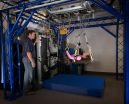(Press-News.org) Use of cholesterol lowering drugs is associated with a one third lower risk of stroke in older adults without previous disease, finds a study published in The BMJ this week.
In high income countries, a growing proportion of heart disease and stroke occur in the oldest people. In France, for instance, people aged 85 years and over accounted for 43% of deaths from coronary heart disease and 49% of deaths from stroke in 2010.
Yet very few people over the age of 70 take part in trials testing cardiovascular drugs, so their benefit in the oldest people remains uncertain. However, lipid lowering drugs are widely used to prevent heart disease and stroke in older age groups. This is known as primary prevention.
So a research team based in France set out to determine the association between use of lipid lowering drugs (statins or fibrates) in healthy older people and long term risk of coronary heart disease and stroke.
They tracked 7,484 men and women (average age 74 years) with no known history of vascular events, such as heart attacks and strokes, living in three French cities (Bordeaux, Dijon, Montpellier).
Face to face examinations took place every two years. Trained nurses and psychologists also performed interviews and took various physical and cognitive measurements. Factors such as education, occupation, income and lifestyle were also taken into account.
After an average follow-up time of nine years, the researchers found that use of lipid lowering drug (statins or fibrates) was associated with a one third lower risk of stroke compared with non-users. But no association was found between lipid lowering drug use and coronary heart disease.
Further analyses, taking account of age, sex, body mass index, blood pressure and blood cholesterol levels, did not show any effect modification, either for stroke or for coronary heart disease.
In a population of community-dwelling older people with no history of vascular events, use of statins or fibrates was associated with a 30% decrease in the incidence of stroke, say the authors.
This is an observational study, so no definitive conclusions can be drawn about cause and effect. Nevertheless, if replicated, the study results suggest that lipid lowering drugs might be considered for the prevention of stroke in older populations, say the researchers.
Despite some limitations, they say their data "raise the hypothesis of protection against stroke related to long term use of lipid lowering drugs for primary prevention in older people, with no difference between statins and fibrates."
They point out that, in their population, the incidence of stroke was low (overall, 0.47 per 100 person years) so a 30% reduction in stroke risk results in a limited number of avoided cases. However, "in other populations more exposed to the risk of stroke, a one third reduction in stroke risk, if confirmed, could have an important effect on public health," says Christophe Tzourio, Professor of Epidemiology at University of Bordeaux and Inserm.
This study will not change guidelines, but the results "are sufficiently compelling to justify further research testing the hypothesis that lipid lowering may be effective in the primary prevention of stroke in older people," says Graeme Hankey, Professor of Neurology at the University of Western Australia, in an accompanying editorial.
Meanwhile, for clinicians and patients, he says the decision to start statins for primary prevention of vascular disease in people over 75 "continues to be based on sound clinical judgment" after considering each person's predicted vascular risk with and without statins, their predicted risk of adverse effects, and the patient's own priorities and preferences for treatment.
INFORMATION:
COLUMBUS, Ohio - A new study in animals suggests that skipping meals sets off a series of metabolic miscues that can result in abdominal weight gain.
In the study, mice that ate all of their food as a single meal and fasted the rest of the day developed insulin resistance in their livers - which scientists consider a telltale sign of prediabetes. When the liver doesn't respond to insulin signals telling it to stop producing glucose, that extra sugar in the blood is stored as fat.
These mice initially were put on a restricted diet and lost weight compared to controls ...
(SACRAMENTO, Calif.) -- Many of those who should get it, don't. And many of those who shouldn't, do. That's the story of a common screening test for osteoporosis, according to new research from UC Davis Health System.
The study, published online today in the Journal of General Internal Medicine, found that screening rates increased sharply among women at age 50, despite guidelines suggesting screening at age 65 unless risk factors are present. The presence of risk factors only had a modest influence on screening decisions.
Osteoporosis causes bone density to diminish ...
A dramatic video has captured the behaviour of cytotoxic T cells - the body's 'serial killers' - as they hunt down and eliminate cancer cells before moving on to their next target.
In a study published today in the journal Immunity, a collaboration of researchers from the UK and the USA, led by Professor Gillian Griffiths at the University of Cambridge, describe how specialised members of our white blood cells known as cytotoxic T cells destroy tumour cells and virally-infected cells. Using state-of-the-art imaging techniques, the research team, with funding from the ...
Decades' worth of textbook precepts about how our immune systems manage to avoid attacking our own tissues may be wrong.
Contradicting a long-held belief that self-reactive immune cells are weeded out early in life in an organ called the thymus, a new study by Stanford University School of Medicine scientists has revealed that vast numbers of these cells remain in circulation well into adulthood.
"This overturns 25 years of what we've been teaching," said Mark Davis, PhD, professor of microbiology and immunology and director of Stanford's Institute for Immunity, Transplantation ...
Scientists are reporting development of a new way to modify interleukin-2 (IL-2), a substance known as a cytokine that plays key roles in regulating immune system responses, in order to fine-tune its actions. Harnessing the action of IL-2 in a controllable fashion is of clinical interest with potential benefit in a range of situations, including transplantation and autoimmune disease. The modified IL-2 molecules inhibited the actions of endogenous IL-2, potentially more effectively than existing agents, as well as inhibited the actions of another interleukin, IL-15, with ...
A team led by researchers from Massachusetts General Hospital (MGH) and the Ragon Institute of MGH, MIT and Harvard has found that the most common bacterial community in the genital tract among healthy South Africa women not only is significantly different from that of women in developed countries but also leads to elevated levels of inflammatory proteins. In a paper in the May 19 issue of Immunity, the investigators describe finding potential mechanisms by which particular bacterial species induce inflammation and show that the presence of those species and of elevated ...
Ever since single-layer graphene burst onto the science scene in 2004, the possibilities for the promising material have seemed nearly endless. With its high electrical conductivity, ability to store energy, and ultra-strong and lightweight structure, graphene has potential for many applications in electronics, energy, the environment, and even medicine.
Now a team of Northwestern University researchers has found a way to print three-dimensional structures with graphene nanoflakes. The fast and efficient method could open up new opportunities for using graphene printed ...
HIV infections continue to rise in a new generation of young, gay, bisexual and other men who have sex with men (YMSM) despite three decades of HIV prevention as well as recent availability of biomedical technologies to prevent infection. In the U.S., it is estimated that 63% of incident HIV infections in 2010 were among YMSM despite the fact that they represent a very small portion of the population. Given this heightened risk for HIV seroconversion among YMSM, researchers at New York University's Center for Health, Identity, Behavior & Prevention Studies (CHIBPS) sought ...
ANN ARBOR, Mich. -- Why do some cancer cells break away from a tumor and travel to distant parts of the body? A team of oncologists and engineers from the University of Michigan teamed up to help understand this crucial question.
Cancer becomes deadly when it spreads, or metastasizes. Not all cells have the same ability to travel through the body, but researchers don't understand why.
In a paper published in Scientific Reports, researchers describe a new device that is able to sort cells based on their ability to move. The researchers were then able to take the sorted ...
Run far or run fast? That is one of the questions NASA is trying to answer with one of its latest studies--and the answers may help keep us in shape on Earth, as well as in space. Even with regular exercise, astronauts who spend an extended period of time in space experience muscle weakening, bone loss, and decreased cardiovascular conditioning. This is because they no longer have to work against gravity in everyday living.
NASA's Human Research Program Integrated Resistance and Aerobic Training study, known as iRAT, completed recently to evaluate the use of high intensity ...


